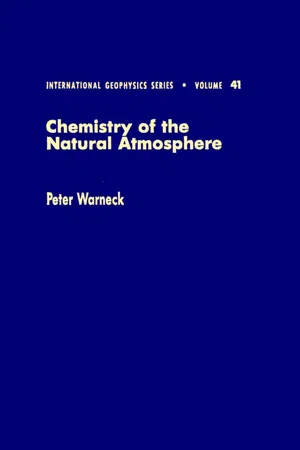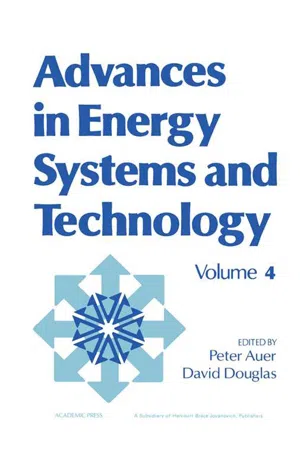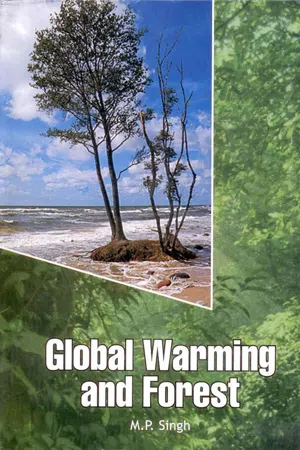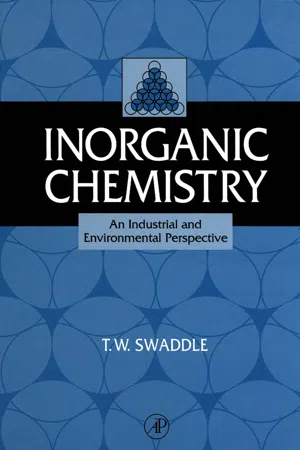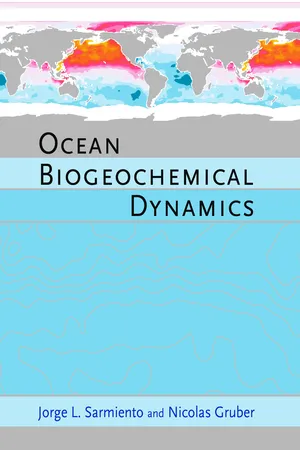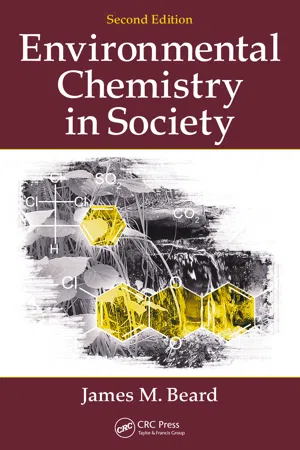Geography
Carbon in Atmosphere
Carbon in the atmosphere refers to the presence of carbon dioxide (CO2) and other carbon-based gases in the Earth's air. These gases contribute to the greenhouse effect, trapping heat and leading to global warming and climate change. Human activities, such as burning fossil fuels and deforestation, have significantly increased the amount of carbon in the atmosphere, impacting the planet's climate and ecosystems.
Written by Perlego with AI-assistance
Related key terms
1 of 5
10 Key excerpts on "Carbon in Atmosphere"
- eBook - PDF
- Warneck(Author)
- 1988(Publication Date)
- Academic Press(Publisher)
Chapter I 11 Geochemistry of Carbon Dioxide 11.1 Introduction Atmospheric carbon dioxide is chemically quite inert except at high altitudes, where it is subject to photodissociation. At the Earth’s surface, CO, occurs dissolved in the oceans and in the surface waters of the continents. Here, it partakes in several geochemically important reactions, such as the weathering of rocks and the formation of limestone deposits. Another important process involving CO, is its assimilation by plants. Carbon is a key element of life, and atmospheric CO, provides the principal source of it. The consequence of all interactions is a complex system of carbon fluxes connecting a number of well-diff erentiated geochemical reser- voirs: the atmosphere, the biosphere, the oceans, and the sediments of the Earth’s crust. Reservoirs and fluxes combined describe the geochemical carbon cycle. The atmosphere cannot be isolated from the rest of the system, because the abundance of CO, in air is governed by the behavior of the other reservoirs to which the atmosphere is coupled and by the associated exchange processes. To elucidate what controls atmospheric CO, thus requires a detailed discussion of the major reservoirs and their interactions. The current great interest in carbon dioxide derives from the observed rise of its concentration in the atmosphere and a growing concern about the prospect of climatic changes if the trend continues. It was Callendar 543 544 11 GEOCHEMISTRY OF CARBON DIOXIDE (1938) who first noted the increase since the turn of the century, but systematic measurements of the trend were not begun until 1957. Since then, a unique record of atmospheric COz mixing ratios has been obtained at Mauna Loa, Hawaii, and somewhat less extensively at the South Pole (see Fig. 1-2). These data document the annual increase of CO, over a period of at least 20 yr. Following Callendar, the effect has generally been attributed to the combustion of fossil fuels by humans. - eBook - ePub
- Peter Auer, David Douglas(Authors)
- 2013(Publication Date)
- Academic Press(Publisher)
In the natural biogeochemical processes that take place on our earth, vast amounts of carbon are exchanged among living things, oceans and freshwater, the atmosphere, and components of the solid earth itself. Superimposed on the natural processes are the activities of man. During the nineteenth and twentieth centuries the combination of human population growth and modern technology has resulted in an anthropogenic release of carbon from storage as carbon dioxide. Although the rates of anthropogenic release are still small in relation to the natural exchanges, they are no longer negligible.Carbon dioxide is not usually regarded as a pollutant in the atmosphere, because it exists there naturally at concentrations in the neighborhood of 0.03%. In fact, carbon dioxide is required in the atmosphere for life to exist. Not only is carbon dioxide necessary in the photosynthesis process, on which all life (directly or indirectly) depends, but atmospheric carbon dioxide also provides a temperature-regulating mechanism that gives our planet a thermal regime suitable for human habitation. Without enough carbon dioxide in the atmosphere, the earth would be ice covered; and with too much, the earth could be uninhabitably hot.It is this so-called “greenhouse effect” that causes the concern about the concentration of carbon dioxide in the atmosphere. Certain gases, including carbon dioxide and water vapor, are transparent to energy radiated in some wavelengths while absorbing energy radiated in others. Carbon dioxide is relatively transparent to visible light (energy) from the sun, but absorbs energy in the IR (heat) wavelengths of the earth’s radiation to space. With or without increased CO2 , the energy leaving the earth must be the same as that received from the sun; with increased CO2 this requires a change in the thermal structure of the atmosphere—increasing temperatures near the surface and decreasing temperatures at higher altitudes. It is this change in the thermal structure that could result in a profound and long-lasting change in the earth’s climate.This result of increasing atmospheric carbon dioxide suggests that significant changes in precipitation patterns in several critical agricultural areas of the world may take place. The indicated warming near the earth’s surface also suggests that some of the high-latitude ice in both hemispheres might melt, and for the cases of glaciers located on land, one result would be the rising of sea levels. Because substantial time is required to melt enough ice to give a significant rise in sea level, this impact may (for now) be of less concern than the impacts that a global climate change could have on food production. - eBook - PDF
- Singh, M P(Authors)
- 2021(Publication Date)
- Daya Publishing House(Publisher)
Global Carbon Budget Although the year-to-year increase in the carbon dioxide concentration of the atmosphere is largely driven by combustion of fossil fuels and deforestation, natural processes such as exchange of carbon dioxide with the ocean, photosynthesis, respiration of living organisms, and decomposition also play a role. These processes, which constitute the Earth’s carbon cycle, account for about 95 per cent of the total exchange of carbon dioxide with the atmosphere. In reindustrialize times, the global carbon cycle was quite balanced and the atmospheric carbon dioxide concentration remained stable. At present, approximately two-thirds of the carbon dioxide added to the atmosphere by human activities is sequestered by the natural processes-as bicarbonate in the ocean, wood in the forests, and organic matter in the soil. The remaining one third accumulates in the atmosphere, perturbing the radiative properties of the atmosphere and possibly altering the climate. Carbon dioxide sequestration by the global carbon cycle is, therefore, an important factor mitigating the potential impact of human activity on climate. The future course of anthropogenic climate change will depend significantly on how these natural components of the Earth’s carbon cycle respond in the future. Much effort is now focused on understanding where the carbon is going and in establishing a system that will permit scientists to monitor the dynamics of carbon cycling by the world’s oceans and terrestrial ecosystems. The most powerful approach developed to date is based on a ‘top down’ analysis of the dynamics of carbon dioxide and other tracers in the atmosphere. Flask samples of air are collected at frequent intervals at many stations all over the world and sent to central laboratories for analysis of oxygen and carbon dioxide concentrations and other trace gases. One critical measurement is the 13 C and 18 C isotopes of carbon dioxide. - eBook - PDF
- Amrita Pandey(Author)
- 2019(Publication Date)
- Delve Publishing(Publisher)
A brief introduction to the permanent and variable gases has also been explained in brief. A short description of major elements of the atmosphere are also discussed. Towards the end of this chapter, two major atmospheric environmental concerns have also been described. 3.1. INTRODUCTION The atmosphere of the earth is a critical system for life on the planet. Similar to the oceans, the atmosphere also shapes the climate as well as weather patterns of the earth and also makes few regions much more habitable as compared to others. However, the climate of the earth is not static; it is considered to be variable. The term “atmosphere” is basically derived from Ancient Greek ἀ τμός (atmos) , which means ‘vapor,’ and σφα ῖ ρα (sphaira) , which means ‘ball’ or ‘sphere.’ It is a layer or a set of layers of gases that surround the planet or various other material body. The earth comprises an atmosphere, which is generally known as air. Air includes oxygen, which is used for breathing purpose mainly, nitrogen and very less amount of various other gases such as greenhouse gases, which keep the earth quite warm and are appropriate for life. In addition, the air contains the pollution also. Some of the pollution is natural such as dust from the volcanoes but a great amount of pollution is the result of human activities and arises from the burning of fuels for electricity, heat, energy and transportation. In addition, the air comprises a huge amount of water in the form of moisture. When it rains, it can be seen. Rest of the time, the water is present in air in the form of invisible vapor and it is frequently recycled between the atmosphere and the earth through water cycle. Moisture present in the atmosphere is a major cause of the weather. Atmosphere: A Component of Earth Ecosystem 47 Most of the air lies near the surface of the earth that is in the lowest layer of the atmosphere known as the troposphere. - eBook - PDF
Inorganic Chemistry
An Industrial and Environmental Perspective
- Thomas W. Swaddle(Author)
- 1997(Publication Date)
- Academic Press(Publisher)
154 Chapter 8 The Atmosphere and Atmospheric Pollution tion of this is trapped by water vapor, CO2, and certain other greenhouse gases such as methane in the atmosphere, leading to a significant warming of the environment. An extreme example of an apparent C02 greenhouse effect is found on the planet Venus, which has an atmosphere of CO2 and N2 at 100 bars total pressure and a ground temperature of approximately 460 ~ Venus, however, is much closer than the Earth to the Sun. It is believed that the atmospheres of Mars, Venus, and Earth were all originally composed mainly of CO2, N2, and H20. Venus' water is now gone, however, and Earth's CO2 was mostly either locked up as carbonates in sedimentary rocks formed in ~nolanf c~pa~n~ c~r n~rfl~r onn~rarfarl f~ N,., r ') ,z 1119 years -~- thrc~gh photosynthesis by primitive plants and algae. Biological cycling of O2 con- tinues today, and 02 has a residence time of about 5000 years in the at- mosphere. On the Earth, some 400-500 million years ago (in the early Paleozoic era), CO2 levels were 12-20 times those of the present, but they subsequently dropped sharply during the Carboniferous and Permian peri- ods when the rapidly expanding vascular plant population flourished and became buried on a vast scale, forming the massive coal deposits associated with rocks of that age. The consequent diminution in atmospheric CO2 con- centrations and hence lessening of the greenhouse effect may well account for the uniquely long period of glaciation in Permian-Carboniferous time. 12 Normally, the mean atmospheric CO2 concentration is buffered by the oceans, which hold CO2 in solution at the surface and also precipitate it in the depths as limestone (CaCO3) or dolomite [CaMg(CO3)2], and by green plants (biomass), which convert it to carbohydrates. - eBook - PDF
- Jorge L. Sarmiento, Nicolas Gruber(Authors)
- 2013(Publication Date)
- Princeton University Press(Publisher)
Those gases that absorb energy at infrared wavelengths typical of ter- restrial radiation are called greenhouse gases, with CO 2 being one of the most important ones. Biogeochemical cycles can also influence the physi- cal climate system through changes in other climate- relevant properties at the Earth’s surface, e.g., by chang- ing the albedo, i.e., the fraction of shortwave radiation from the sun that is directly reflected back; or by in- teracting with the hydrological cycle, altering the latent heat fluxes associated with condensation and evapora- tion (see figure 10.1.3 and, e.g., Betts [2000]). We will limit our discussion here to the greenhouse effect. The Earth receives short-wavelength radiation emit- ted from the sun, and radiates this energy back to space at longer wavelengths. Figure 10.1.3 shows the flow of Vostok a b c d -400,000 -300,000 -200,000 -100,000 0 Time (Calendar years) -25,000 -20,000 -15,000 -10,000 -5,000 0 150 200 250 300 350 400 atmospheric CO 2 (ppm) Dome C Taylor Dome Taylor Dome Time (Calendar years) 1000 1200 1400 1600 1800 2000 Time (Calendar years) Law Dome Siple Dome D47 & D57 H15 Taylor Dome 1950 1960 1970 1980 1990 2000 atmospheric CO 2 (ppm) 150 200 250 300 350 400 Time (Calendar years) Mauna Loa Figure 10.1.2: Variations in the atmospheric CO 2 concentration over time based on ice core reconstructions and direct observations since 1958. (a) CO 2 variations over the last 400 kyr (1 kyr ¼ 1000 years). (b) CO 2 variations from 25,000 BC to present. (c) CO 2 variations during the last 1000 years as reconstructed from Antarctic ice cores. (d) CO 2 variations during the last 50 years as directly measured in the atmosphere at Mauna Loa, Hawaii. This comparison illustrates that the onset of the industrial revolution led to a dramatic increase of atmospheric CO 2 after a period of relatively stable atmospheric CO 2 during the previous 10,000 years. The present atmospheric CO 2 level is unparalleled in the last 400,000 years. - eBook - PDF
- James M. Beard(Author)
- 2016(Publication Date)
- CRC Press(Publisher)
Which gases are involved? There are several of them. Some of them have been with us since the formation of the planet and others are man-made. The natural greenhouse gases include water vapor, carbon dioxide, methane (CH 4 ), nitrous oxide (N 2 O), and ozone (O 3 ). The man-made greenhouse gases of importance include chlorofluorocarbons , which are known as CFCs or by their trade name, Freon. Carbon Dioxide Probably the most important of these gases is carbon dioxide. As pointed out in Chapter 5, carbon dioxide is one of the key ingredients in the carbon cycle. As we know, the existence of carbon dioxide in the atmosphere is absolutely essential for life. Plants remove carbon dioxide from the air during photosynthesis to create the compounds of life on which both plants and animals depend. Not only is there no 243 GLOBAL ATMOSPHERIC CHANGE direct toxic effect of carbon dioxide, but it is also essential for the existence of life. Carbon dioxide is returned to the air by both plants and animals during respiration. Decomposition of dead plant and animal matter also releases carbon dioxide into the atmosphere. Finally, any burning of organic material also releases carbon dioxide. The level of carbon dioxide in the air has increased dramatically since preindus-trial times when the level was about 280 ppm. As of 2012, the atmospheric concen-tration was approaching 395 ppm. Where did all of this carbon dioxide come from? It came largely from extensive burning. The burning of what? The answer is fossil fuels. Coal, oil, and natural gas all contain considerable amounts of carbon. When these fuels are burned, carbon dioxide is produced. Fossil fuels are the principal energy source used in our society; that is, they are the energy source on which a large majority of things run. - eBook - PDF
Physical Geology
The Science of Earth
- Charles Fletcher(Author)
- 2017(Publication Date)
- Wiley(Publisher)
Furthermore, these energy resources are nonrenewable—that is, it takes millions of years to form fossil fuels, and they exist in limited amounts within the crust. Respiration and the burning of fossil fuels are not the only sources of carbon dioxide. Recall that volcanic eruptions and metamorphic processes also introduce carbon dioxide into the atmosphere, and have done so throughout Earth’s history. Clearly then, carbon dioxide is a natural component of Earth’s atmosphere, so why does it matter that human activities add more? How do we know what carbon dioxide levels in the atmosphere were in the past? And why should we care? Adding Carbon Dioxide Activities such as burning fossil fuels and organic biomass, deforestation, and various other land-use practices account for about 12% of the total amount of carbon dioxide emitted to the atmosphere annually. About 83% of global human greenhouse gas emissions are produced by 25 countries, listed in Table 14.1. Over the past 200 years, carbon dioxide levels in the atmosphere have risen by over 40% (from 280 ppm to more than 400 ppm), and they continue to rise by 2% to 3% each year. Scientists now believe that human activities are responsible for these observed escalations in atmospheric carbon dioxide. Scientists using GCMs predict that by the end of the twenty- first century, we could see carbon dioxide concentrations bet- ween 490 and 1260 ppm (75% to 350% higher than natural concentrations). The global warming associated with this rise in carbon dioxide levels will be greater and faster than the natural fluctuations seen in recent geologic history. Research shows that humans are now adding carbon to the atmosphere at a greater rate than any time in the past 66 million years (when a global extinction occurred as a result of an asteroid impact). - No longer available |Learn more
- (Author)
- 2014(Publication Date)
- Research World(Publisher)
Measured atmospheric concentrations of carbon dioxide are currently 100 ppmv higher than pre-industrial levels. Natural sources of carbon dioxide are more than 20 times greater than sources due to human activity, but over periods longer than a few years natural sources are closely balanced by natural sinks, mainly photosynthesis of carbon compounds by plants and marine plankton. As a result of this balance, the atmospheric concentration of carbon dioxide remained between 260 and 280 parts per million for the 10,000 years between the end of the last glacial maximum and the start of the industrial era. It is likely that anthropogenic warming, such as that due to elevated greenhouse gas levels, has had a discernible influence on many physical and biological systems. Warming is projected to affect various issues such as freshwater resources, industry, food and health. The main sources of greenhouse gases due to human activity are: • burning of fossil fuels and deforestation leading to higher carbon dioxide concentrations in the air. Land use change (mainly deforestation in the tropics) account for up to one third of total anthropogenic CO 2 emissions. • livestock enteric fermentation and manure management, paddy rice farming, land use and wetland changes, pipeline losses, and covered vented landfill emissions leading to higher methane atmospheric concentrations. Many of the newer style fully vented septic systems that enhance and target the fermentation process also are sources of atmospheric methane. • use of chlorofluorocarbons (CFCs) in refrigeration systems, and use of CFCs and halons in fire suppression systems and manufacturing processes. ____________________ WORLD TECHNOLOGIES ____________________ • agricultural activities, including the use of fertilizers, that lead to higher nitrous oxide (N 2 O) concentrations. - eBook - PDF
Atmospheric Chemistry and Physics
From Air Pollution to Climate Change
- John H. Seinfeld, Spyros N. Pandis(Authors)
- 2016(Publication Date)
- Wiley(Publisher)
Geophys. Res. 101 , 1429 – 1434. Ver, L. M. B., et al. (1999), Biogeochemical responses of the carbon cycle to natural and human perturbations: Past, present, and future, Am. J. Sci. 299 , 762 – 801. Zeebe, R. E. (2012), History of seawater carbonate chemistry, atmospheric CO 2 , and ocean acidi fi cation, Annu. Rev. Earth Planet. Sci. 40 , 141 – 165. C H A P T E R 2 3 Global Climate Earth ’ s climate is the result of a balance between incident solar (shortwave) radiation absorbed and thermal infrared (longwave) radiation emitted. Averaged over the globe and over a suf fi ciently long period of time, this balance must be zero. Because virtually all the energy for the climate system comes from the sun, globally the amount of incoming solar radiation on average must be equal to the sum of the outgoing re fl ected solar radiation and the outgoing infrared longwave radiation emitted by the planet. A perturbation of this global radiation balance, be it anthropogenic or natural, is called radiative forcing . Climate refers to the mean behavior of the weather over some appropriate averaging time. The actual averaging time when de fi ning climate is not immediately obvious; times too short are insuf fi cient to average out normal year-to-year fl uctuations; times too long may incur on timescales of climate change itself. Timescales of relevance for climate change can range from decades to millennia. A traditional averaging time for de fi ning climate is 30 years. The most fundamental climate variable is the global annual mean surface temperature, although other variables can also be considered. 23.1 EARTH ’ S ENERGY BALANCE Annually averaged, Earth receives 341 W m 2 of solar radiation at the top of the atmosphere (Trenberth et al. 2009) (Figure 23.1). Of this amount, ∼ 102 W m 2 is re fl ected back to space by Earth ’ s surface and by clouds and particles in the atmosphere. As a result, the net radiant energy absorbed by Earth is 239 W m 2 .
Index pages curate the most relevant extracts from our library of academic textbooks. They’ve been created using an in-house natural language model (NLM), each adding context and meaning to key research topics.
